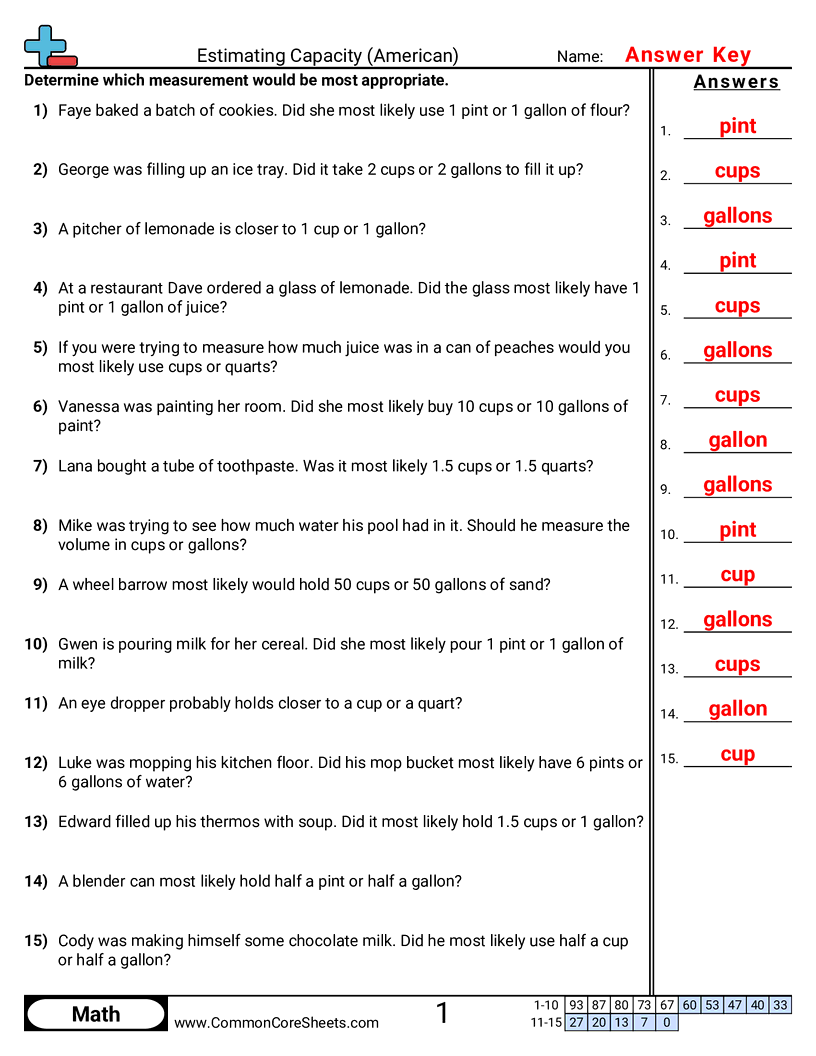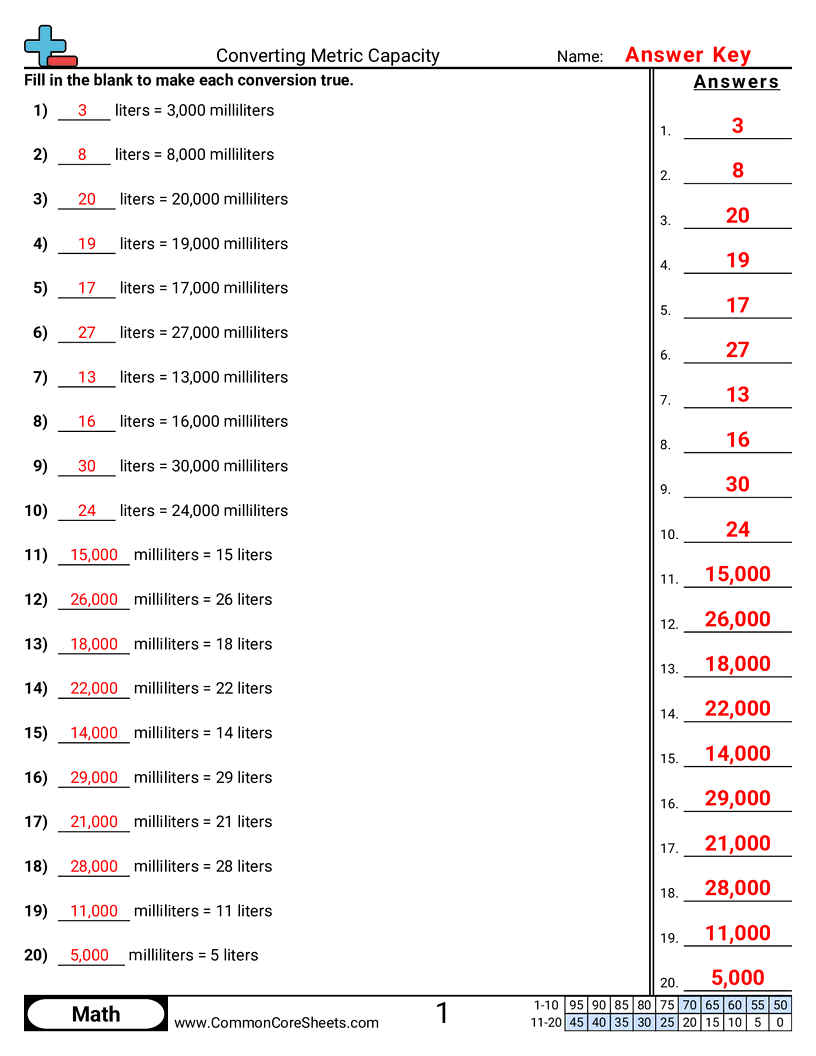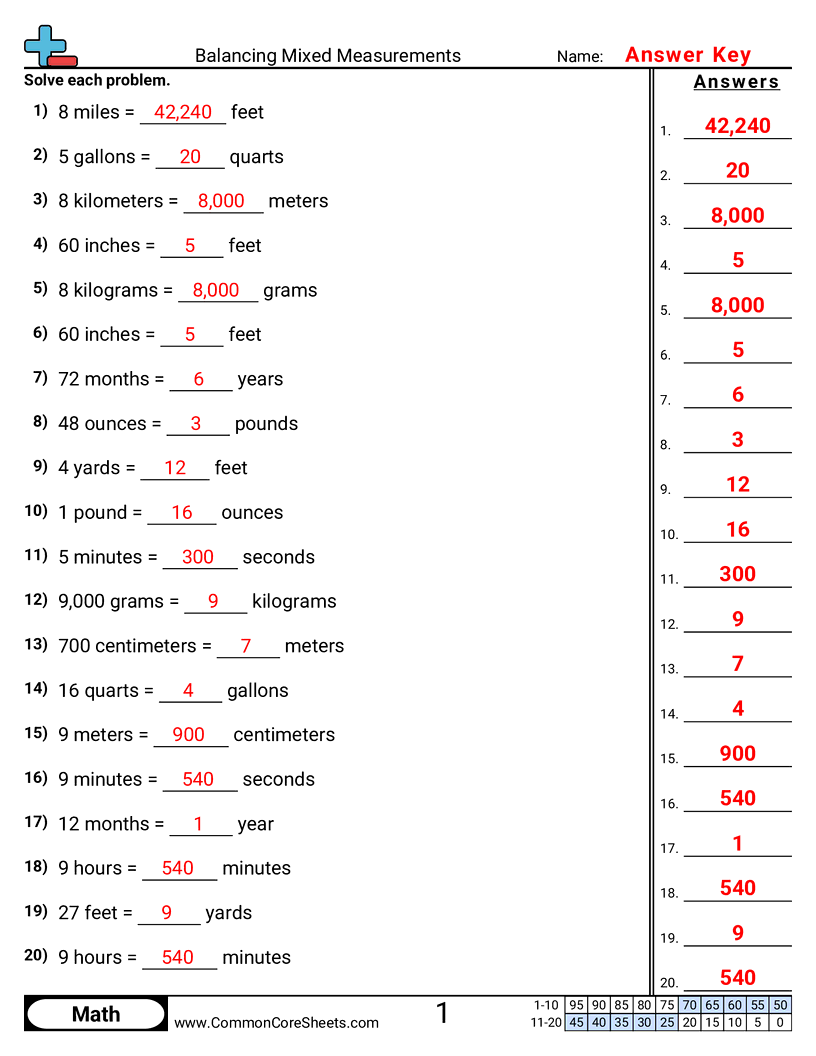Free capacity worksheets with answer key. No login or account needed. From visually identifying capacity to solving capacity word problems, we've got you covered. A grading column and quick grade scale maker grading a breeze and a modified pages help with lower level learners or when just introducing a topic. Great for teachers or for homeschool. Great for teachers or for homeschool.
Browse Sheets By Problem Type
×

4md1


×
Description:
This worksheet is designed to familiarize children with the concept of estimating capacity, utilizing US customary units. It includes engaging visuals and math problems based around items like measuring cups, barrels, and tea cups. This customized worksheet can be converted into flash cards or adapted for distance learning, providing a versatile tool for both teachers and parents in making learning about capacities fun and interactive.

×
Student Goals:
Conceptual UnderstandingAfter completing the worksheet, students should have deepened their understanding of American capacity measurements, including cups, pints, quarts, gallons, and liters. They should also be able to associate these units of measurement with everyday objects and substances, reinforcing the practical application of these concepts.Problem-solving SkillsThe worksheet exercises a range of problem-solving skills. Students should be able to make reasonable estimations of the capacity of everyday items using different units of measure. Through this practice, they will have developed the ability to approach problems logically and apply their knowledge and understanding effectively to find solutions.Critical Thinking SkillsProgressing through the problems should sharpen students' critical thinking skills. They should be able to make estimations based on their understanding of capacity units, comparing different units and choosing the appropriate one for each item or scenario. This requires reflecting on the properties of each unit and their real-world implications, thereby stimulating and enhancing critical thought processes.Real-world ApplicationSuccessfully completing the worksheet ensures students have learned to apply their knowledge of capacity measurement units to realistic, everyday situations. They should be able to estimate the capacities of various household objects or substances in different units of measures, such as understanding how much soda a can holds or the capacity of an ice chest, which makes their learning relevant and practical.Performance EvaluationThis worksheet also serves to evaluate student performance in the field of measurement estimation. Based on the completion of this worksheet, students will be able to identify their strengths and areas for improvement in understanding American capacity units. This can guide their subsequent learning and study strategies in mathematics, particularly in the area of measurement and estimation.


4md1


×
Description:
"This worksheet is designed to help children understand and estimate capacity using American units through practical examples in 15 Math problems. Subjects range from determining the volume of common items such as a packet of ketchup to larger volumes such as a swimming pool. Tailored to suit individual learning needs, the worksheet can be customized, converted into flashcards, or utilized in a distance learning setting, promoting versatile and engaging education."

×
Student Goals:
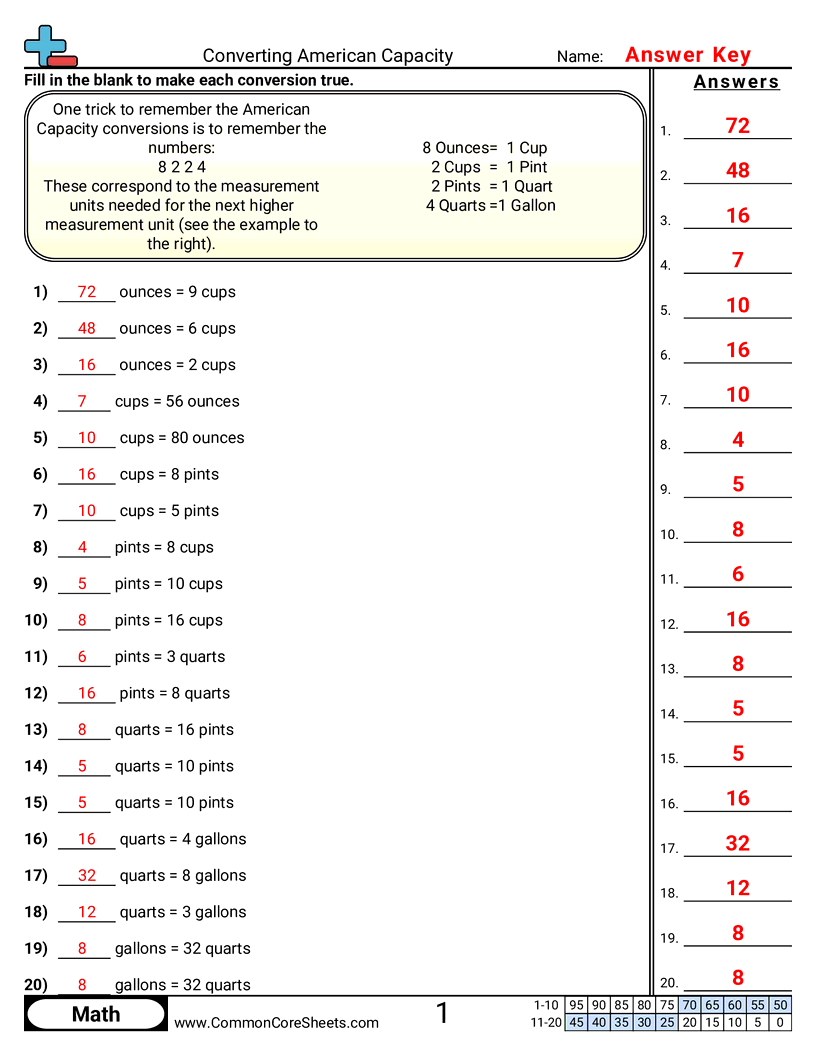
5md1


×
Description:
"This worksheet is designed to help children explore the concept of American capacity conversions in a fun and engaging way. With 20 interesting math problems, it helps students learn to convert ounces into cups. The convertible format of this worksheet allows it to be customized, transformed into flashcards, or used seamlessly in distance learning environments."

×
Student Goals:
Understanding American Capacity UnitsAfter completing the worksheet, students will have a deep understanding of American capacity units including ounces, cups, and pints. They will comprehend how these units interrelate and correspond to each other, providing a crucial foundation for further learning in practical measurement scenarios.Practical Application of Mathematical KnowledgeThe completion of the worksheet equips students with the ability to practically apply their mathematical knowledge in daily situations. Be it cooking, purchasing grocery, or comparing the volumes of different containers, students will be skilled at making conversions between ounces, cups, and pints, which are common household measuring units in the United States.Enhanced Problem-Solving SkillsThe worksheet comprises of conversion problems that necessitate critical thinking and cognitive reasoning. Thus, upon completion, students will have enhanced their problem-solving skills. They will be adept at breaking down complex problems into simpler units, applying their theoretical knowledge, and arriving at a logical conclusion.Increased Numeracy SkillsWorking through this worksheet will result in improved numeracy skills. Students will strengthen their skills not only in arithmetic but also in the practical application of these operations. They will become quite facile with the conception of converting units, which is an important aspect of numerical proficiencyPreparation for Advanced Mathematical ConceptsThe worksheet moreover serves as a building block for more advanced mathematical concepts. The ability to convert units plays a vital role when learning concepts like ratios, proportions, and rates, therefore, accomplishment of this worksheet will equip students with skills required to succeed in advanced levels of math.Confidence and Self-Efficacy in MathematicsThe completion of the worksheet instills in students a sense of achievement and self-efficacy, thereby motivating them to tackle more complex problems. By working through these problems independently and successfully, they gain confidence in their own abilities to understand and apply mathematical concepts in practical scenarios.


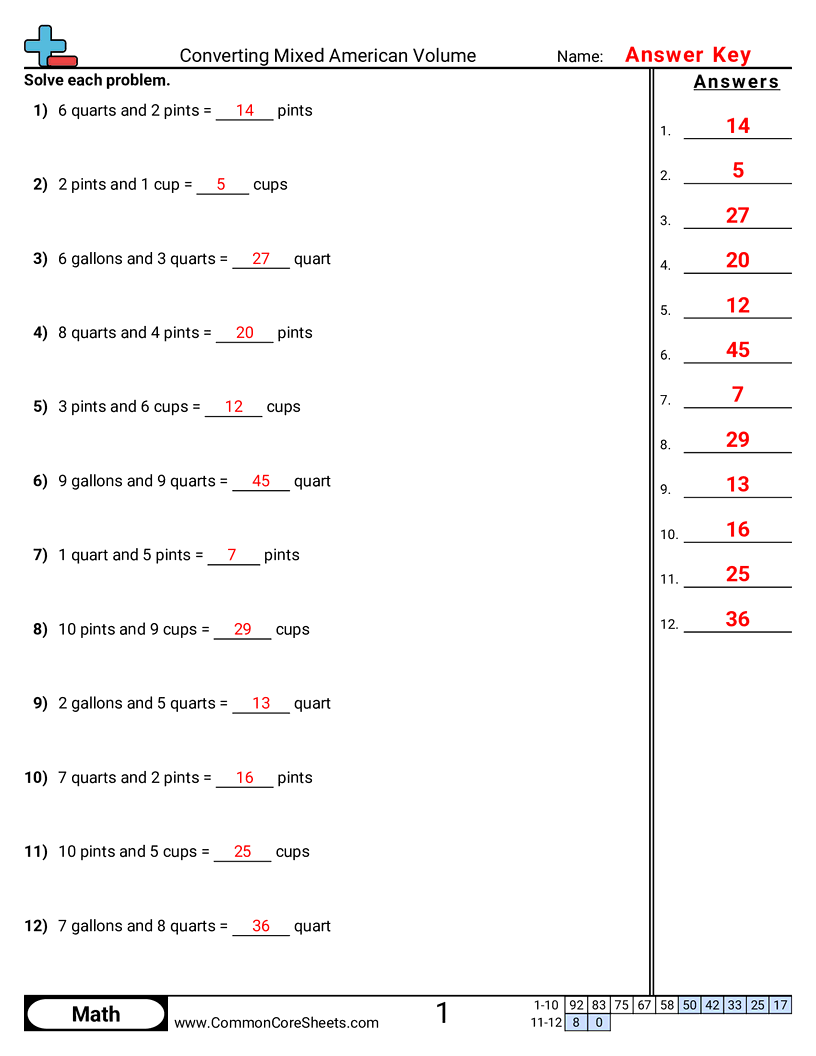


×
Description:
"This worksheet is designed to enhance children's math skills by teaching them to convert different American volume units. It offers 12 customisable problems involving the conversion of units such as quarts to pints, pints to cups, and cups to ounces. This worksheet is ideal for distance learning and can also be converted into flashcards for interactive and effective learning."

×
Student Goals:
Understanding of volume conversionBy successfully completing this worksheet, students should acquire an in-depth understanding of the American system of volume measurements. They will learn to convert units such as quarts, pints, cups, ounces, tablespoons, and teaspoons into one another. This understanding will enable them to more readily undertake tasks that require the conversion of these units in daily life.Problem-solving skillsStudents will improve their problem-solving skills as they navigate through the various conversion problems. They will learn to analyze the problems, apply proper unit conversion rates, perform calculations and interpret the results accurately.Practical Math ApplicationThe worksheet presents practical scenarios where learners may need to use their math skills in actual life situations. They will appreciate the relevance of math in everyday activities, such as cooking or grocery shopping, that require the conversion of volume units in recipes or comparison of product quantities.Enhanced Numeracy SkillsWorking through these math problems will enhance students’ numeracy skills. They will become more confident in handling numbers and carrying out calculations, an essential competence that is applicable across multiple disciplines.Improved AccuracyStudents are tasked with converting mixed units of measure, a process that requires attention to detail for accurate results. With time, practicing these conversions will assist students in decreasing the number of errors made during calculation, thereby improving their overall accuracy.Mental Math BoostCompleting this worksheet will boost learners' mental math abilities. Converting volume units frequently, and without a calculator, can help students to develop quicker arithmetic calculation skills.Expanded VocabularyLastly, this worksheet will contribute to students' mathematical vocabulary. Familiarity with American volume units like quarts and pints, and their abbreviation, will extend their mathematical language and communication skills.



3md2


×
Description:
"This worksheet is designed to help children understand the concept of estimating capacity in metric units. Featuring nine engaging problems, children will estimate the capacity of objects like a cereal bowl, bathtub, and the sand a wheelbarrow holds. Is it 1 milliliter or 500? The worksheet is versatile and can be easily customized for all learning levels, converted into flash cards, or utilized in distance learning. It's a fun and practical way to reinforce math skills at home or in the classroom."

×
Student Goals:
Understand and Apply Capacity ConceptsUpon completion of the worksheet, students should have a clear comprehension of capacity and its application in real-life scenarios. They will learn how to estimate the capacity of various containers and substances, fostering their practical measurement abilities. The practical problems presented on the worksheet would help children develop a strong understanding of metric units such as milliliters and liters, and when to use each appropriately.Enhance Numerical ProficiencyThe worksheet will facilitate the enhancement of students' quantitative ability as they engage quantitatively with the real world. By comparing and identifying correct numbers for the various problems, students will not only hone their mathematical skills but also develop their critical thinking, reasoning, and decision-making abilities.Apply Knowledge to Real-life ContextsBy estimating the capacity of everyday items like a bottle of shampoo or a pitcher of liquid, students will learn the applicability of their mathematical knowledge. This reinforces the lesson that math is not merely abstract numbers but a useful tool in understanding and navigating the everyday world. The worksheet helps children make connections between their classroom learning and its relevance to the world around them.Develop Problem-Solving SkillsTackling the problems in the worksheet requires students to deploy strategic thinking and problem-solving skills. As they sift through different options to find the correct answer, they exercise their ability to analyze, evaluate, and deduce. This worksheet thus aids in the development of logical reasoning and problem-solving skill which are essential in various aspects of life and career.Boost Confidence in Understanding Capacity-Related ProblemsSuccessfully solving the problems in the worksheet can help students gain confidence in their understanding of capacity-related scenarios. This confidence can translate into improved performance not just in math, but in other subjects and general learning too. By being engaged and challenged, students feel accomplished, boosting their overall morale and confidence in learning.


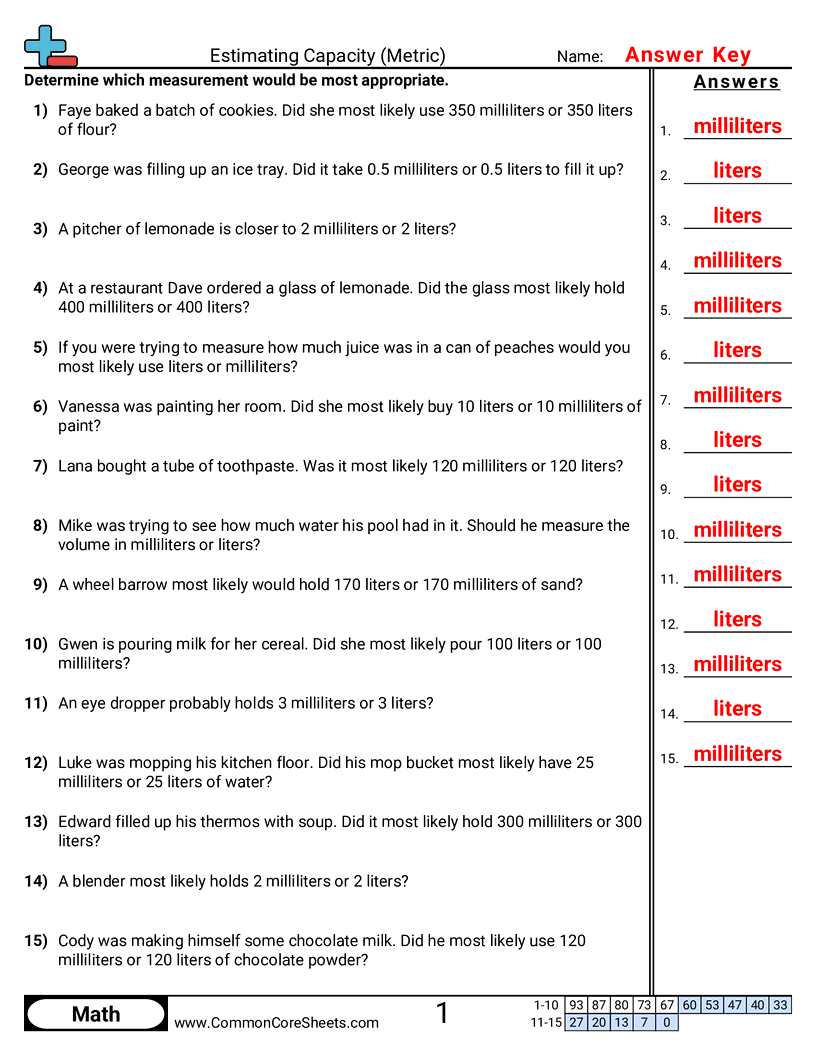
3md2


×
Description:
"This worksheet is designed to enhance children's math skills by estimating capacity using metric measurements. It contains 15 engaging problems prompting kids to differentiate between milliliters and liters in practical scenarios. Customizable for individual learning needs, it can also be converted into flash cards for revising purposes, and is suitable for distance learning sessions. A great tool for learning metric units of volume effectively."

×
Student Goals:
Understanding of Capacity EstimationsUpon completing the worksheet, students should have a good understanding of the concept of capacity and be able to estimate the probable capacity of everyday objects and situations in real life. They should be able to effectively differentiate between milliliters and liters and grasp the magnitude of each unit of measurement, exhibiting a significant improvement in their numeracy skills.Enhancement in Problem SolvingThrough engaging with these capacity-related problems, children will develop their critical thinking and problem-solving skills. They will learn how to infer information from given contexts and apply their mathematical knowledge to estimate and judge the capacity of different scenarios, drastically improving their logical reasoning abilities.Integrating Math Knowledge with Everyday SituationsStudents will be able to take their learned math principles and integrate them into everyday scenarios. The capacity estimation problems represented in the worksheet are based on common household items and actions, thus the exercise highlights the use of mathematical concepts in their routine, enhancing their contextual understanding of measurement units.Boost in Analytical skillsDetermining whether the capacity of an item is closer to certain milliliters or liters will challenge the students’ analytical skills. As they practice, their capability to swiftly and accurately make such judgments should improve, providing a boost in their analytical skills that can be applied in various situations beyond mathematics.Confidence in Decision MakingBy continuously estimating and deciding between two given units, students will gain confidence in their decision-making abilities. This task will allow them to trust their own judgments and make decisions independently, thereby fostering an increase in their self-confidence and autonomy.Understanding of Practical Applications of MathThe worksheet will enhance students' understanding of the practical applications of mathematics. They will learn to appreciate how the math concepts they learn in the classroom pervade everyday life, demonstrating the real-world utility of their classroom learning, and inspiring them to seek out more practical applications of their knowledge in the future.Progress in Metric ComprehensionStudents will make substantial progress in their metric comprehension skills. As they learn to estimate the magnitude of various quantities in liters and milliliters, they will improve their understanding of metric units. In the process, they will also gain a clearer sense of the ordinality and patterning of numbers in the metric system.


5md1


×
Description:
"This worksheet is designed to help children master the concept of converting metric capacity in math. Includes 20 problems, demonstrating conversion between liters and milliliters, that reinforce practical applications of metric measurements. Versatile in format, it can be customized to suit individual needs, transformed into flash cards for quick reference, or used in distance learning settings to enhance comprehension of metric conversion."

×
Student Goals:
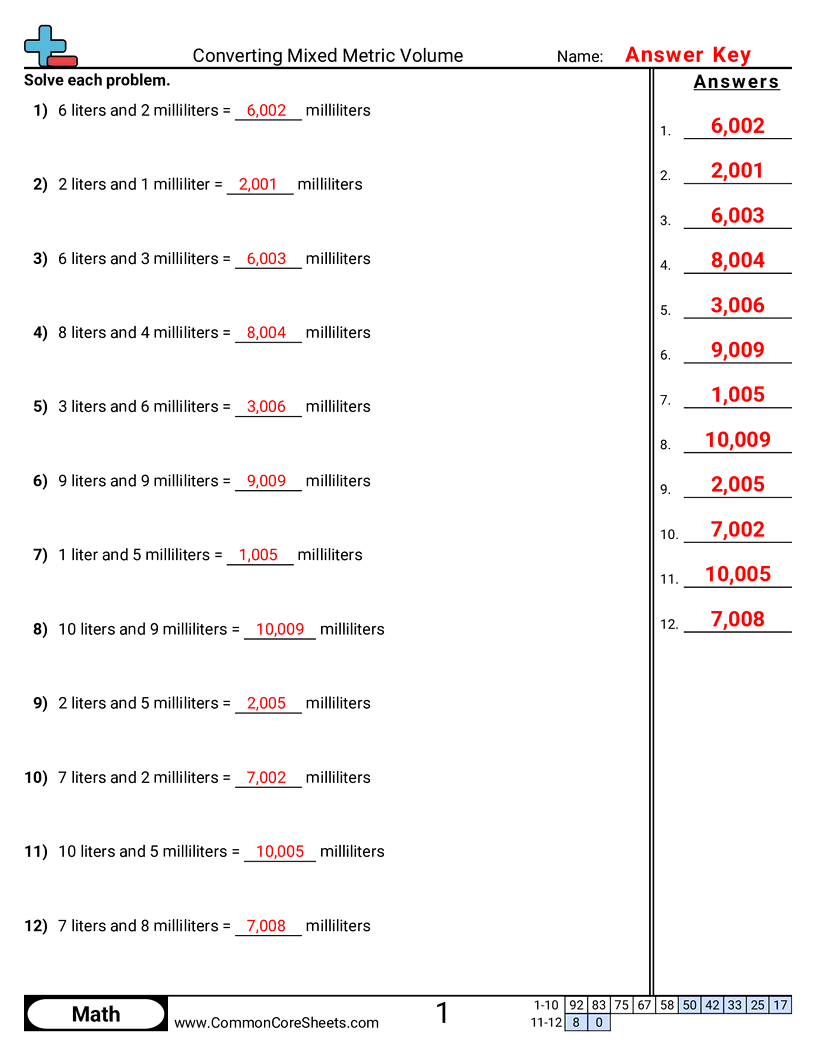


×
Description:
"This worksheet is designed to teach children the fundamentals of converting metric volumes. It consists of 12 math problems that transform liters and milliliters into a singular metric unit, aiding in the understanding of measurements in a simple, engaging manner. Customizable for individual learning pace, these exercises can also be converted into flashcards or adopted for distance learning to enhance flexible education landscapes."

×
Student Goals:
Understanding Metric VolumeUpon completion of this worksheet, students should have a firm understanding of metric volume measurements, specifically dealing with liters and milliliters. They will have gained practical experience in interpreting and converting volumes from liters to milliliters. This understanding is important in the world of science and everyday life, where various units of measurement are consistently used and converted.Boosting Math SkillsThe worksheet is designed to reinforce basic math skills in addition to teaching volume conversion. By working through the problems, students would have practiced simple addition in cases where liters and milliliters are added together, indirectly improving their arithmetic capabilities. This will allow them to level up their quantitative aptitude which is a fundamental aspect of mathematics.Improving Problem-solving AbilitiesThis exercise demands that students apply their knowledge to solve practical problems. They should be able to successfully assess a volume-related problem, identify the correct method to solve it, and implement this solution to get an answer. This continual practice is crucial in developing robust problem-solving skills, a key requirement across all scientific and non-scientific subjects.Enhancing Logical ThinkingBy converting mixed metric volumes, students stimulate loads of logical thinking. The worksheets require them to mentally visualize volumes in the form of liters and milliliters, which enhances their perception and comprehension. This process necessitates the application of logical reasoning, which is a principal focus of educational curricula and a vital skill in interpersonal relations and decision making.Developing Confidence and IndependenceAfter completing the worksheet, students will gain a sense of accomplishment that boosts their confidence in their ability to handle similar problems in the future. Furthermore, as they work independently, they learn to rely on their own understanding, which not only heightens self-confidence but also encourages independence in learning and critical thinking.




×
Description:
"This worksheet is designed to enhance children's math skills by focusing on balancing mixed measurements. It features 20 problem sets involving liter-milliliter, year-month, gallon-quart, milliliter-liter, meter-kilometer, minute-hour, foot-inch, day-hour, day-week, and month-year conversions. This flexible learning tool comes with customization options, is convertible into flash cards, and supports distance learning, catering to diverse learning styles and methods."

×
Student Goals:

